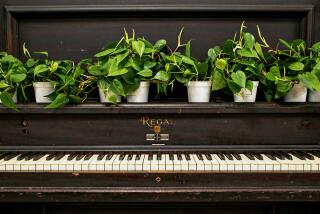Key Elements in Keeping a Grand Effect
- Share via
There are knickknack people and there are people who won’t consider a piece of home furnishing unless it has to be delivered in a container ship.
Each have peculiar problems to solve. Knickknack folks are, for the most part, minimalists who tend to buy many small items, often on impulse: tiny porcelain bunnies, miniature sculptures of the Panama Canal, a set of Gorbachev nesting dolls, paperweights made of everything from lava to plutonium.
They acquire this stuff by the ton. As a consequence, not a single square inch of their furniture can be seen. Every shelf, every tabletop, every dresser, end table and ledge is filled with the fruits of their pack-ratting.
The maximalists, on the other hand, run up their credit card limits by renting derricks. They sleep in custom triple-king-sized beds, bathe in tubs painted with racing lanes, work at desks the size of helicopter pads. When they watch television, Dan Rather appears Godzilla-sized. Any of their hallways can accommodate a brisk 5-iron shot, and a fire in the kitchen wouldn’t set off the smoke detector in the next room. They keep buffalo as pets.
Both factions, however, seem to like pianos. The Lilliputian may see the piano as yet another surface to fill up with fussy attic items, and the bigger-is-better crowd may see it as a piece of furniture with really serious heft (ever try to shove around one of the truly big Bosendorfer grands?), but few people, it seems, bother to puzzle out the question of the ideal location in the house for the instrument.
The National Piano Foundation thinks that’s quite an oversight and, as part of its promotion of September--which, coincidentally, is National Piano Month as declared by the foundation--wants to save piano owners, and potential owners, a bit of grief if they’re considering placing their Steinways next to the Bessemer converter in the den.
Dana Eggerts, a Costa Mesa-based interior designer, is carrying the banner for the group in Orange County this month, and she says that if you treat your piano in much the same way you’d handle a cranky infant, you and your 88s should enjoy a long and tuneful life together.
The main barrier between you and an enduring association with your piano, says Eggerts, is weather, specifically temperature in any extreme. While you can’t keep your piano in a case the way woodwind and string players can, nestled in velvet and away from the vicissitudes of nature, you can at least keep it away from the window. Any direct sunlight falling on the piano will heat it up and cause not only the wood, but the iron frame, the strings and even the keys to expand, says Eggerts.
Not only will this sort of expansion cause the instrument to go out of tune, but over time it can fade the wood, says Eggerts.
The environment around the piano, she says, ought to be kept at “between 60 and 90 degrees, just like you would for people.”
Extremes of humidity also are the piano’s enemies. A room that feels like either a rain forest or a desert affects the wood in much the same way as do extremes of heat and cold. A 9-foot grand piano may look as indestructible as a tank, and as difficult to push around, but it helps to always remember that it is a precision instrument. When you strike that A above middle C, the air is supposed to vibrate at 440 beats per second.
That A will sound its best, says Eggerts, if the piano is sitting in a room with upholstered walls. Fabric wall covering is a good second choice. The upholstery doesn’t necessarily dampen or muffle the sound; rather, it keeps the sound from being reflected and bouncing around the room like balls on a pool table. If you’re impressed by such reverberation, line the walls with concrete and don’t carpet the floor.
Don’t, however, forget about lighting, says Eggerts. Playing the piano is a highly visual as well as tactile task (unless you’re Ray Charles, who could probably play the piano by mail), and you don’t want to squint at the music. Recessed ceiling lighting is best, says Eggerts. Carefully directed track lights also work.
And, she says, if you’re a player who doesn’t mind performing for friends, you’ll want to show off a bit. Position the piano so that others who are sitting and listening elsewhere in the room can see the keyboard. If your guests can see your fingers working, it saves you having to emote facially in order to persuade them that what you’re playing is incredibly difficult.
Of course, you’ll want to make sure that you’ll be able to position the piano at all. Remember, most of them tend to be big, a victory for the maximalists. You have to be able to get it through the door and have enough space left in the room for the bench.
And, if you’re a minimalist, a tiny bust of Bach. And all his children.


